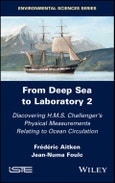The scientific expedition of H.M.S. Challenger in the 1870s marks the starting point of physical oceanography. This ship traveled the seas of the globe pursuing a dual objective: to conduct an in-depth study of animal life and to observe the physical properties of ocean waters.
Volume 2 analyzes and uses for the first time the physical measurements collected by the scientists of the Challenger to show that their surveys establish the link between ocean circulation and the distribution of the ocean’s temperature.
From Deep Sea to Laboratory is available in three volumes for curious readers drawn to travel, history and science. Students, researchers and teachers of physics, fluid mechanics and oceanography will find material to deepen their knowledge.
Table of Contents
Foreword vii
Preface xi
Notations xv
Chapter 1. The Vertical Distribution of Temperature in the Ocean 1
1.1. Introduction 2
1.2. Measuring the temperature of ocean waters 5
1.2.1. Ordinary thermometers 8
1.2.2. Recording thermometers 10
1.2.3. Electric thermometer 19
1.3. Sources of errors in temperature measurement 21
Chapter 2. Global Ocean Circulation 33
2.1. Introduction 34
2.2. Global ocean circulation 38
2.2.1. Geostrophic flow 40
2.2.2. Sverdrup relation: transport of planetary vorticity or effect of latitude on flow? 52
2.3. Conclusion and summary 67
Chapter 3. A Brief Consideration of Thermocline Properties 71
3.1. Modeling of the thermocline 72
3.1.1. Taking heat exchanges into account 72
3.1.2. Setting up boundary conditions 82
3.2. Assumptions used to solve the thermocline model 87
3.2.1. First simplified approaches 87
3.2.2. Approach proposed by the authors 88
3.2.3. Formulating the equation of state 93
3.2.4. Discussion 100
3.3. Characteristic properties of the thermocline 101
3.3.1. Determining the characteristic scale of the thermocline depth from measurements 101
3.3.2. Examples of empirical expressions of k0th(θ)-1 106
3.3.3. Vertical velocity at the base of the thermocline 109
3.3.4. Ocean water temperature, measurements and models 111
Chapter 4. Effect of the Ocean Mixed Layer (OML) 117
4.1. Ocean mixed layer modeling 118
4.1.1. Ekman layer 124
4.1.2. Consequences of Ekman transport 134
4.1.3. Conclusion and summary 141
4.2. Coupling between the OML and the geostrophic layer 143
4.2.1. Taking the bottom boundary layer into account 147
4.2.2. Coupling of Ekman boundary layers with the thermocline 158
4.3. Seasonal fluctuations 175
4.3.1. Role of the vertical temperature gradient in the OML 178
4.3.2. Effect of the Earth’s rotation on stratification 182
4.4. Role of sea ice 187
4.5. Thermohaline circulation 192
Conclusion 197
References 201
Index 205
Summary of Volume 1 209








